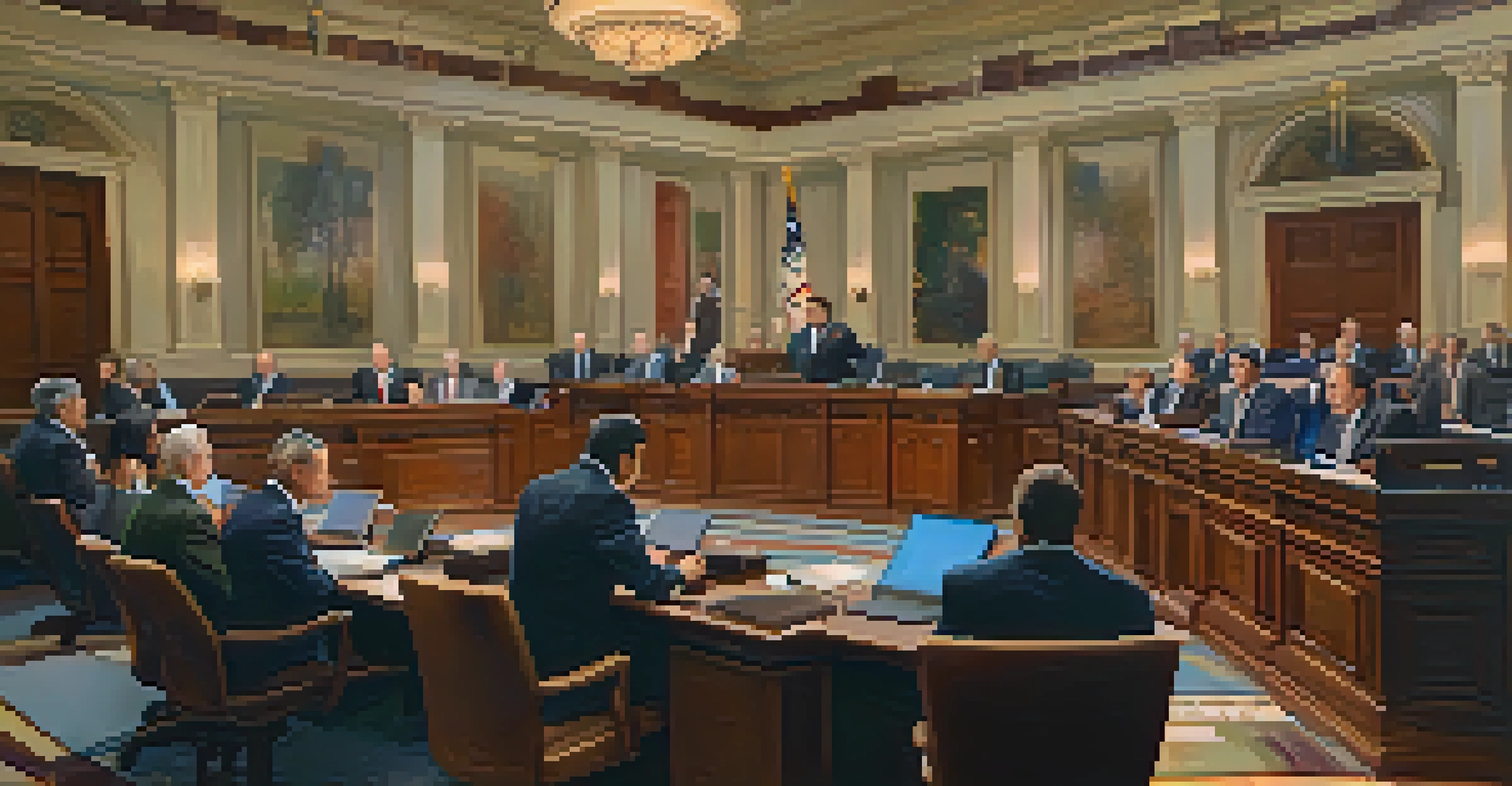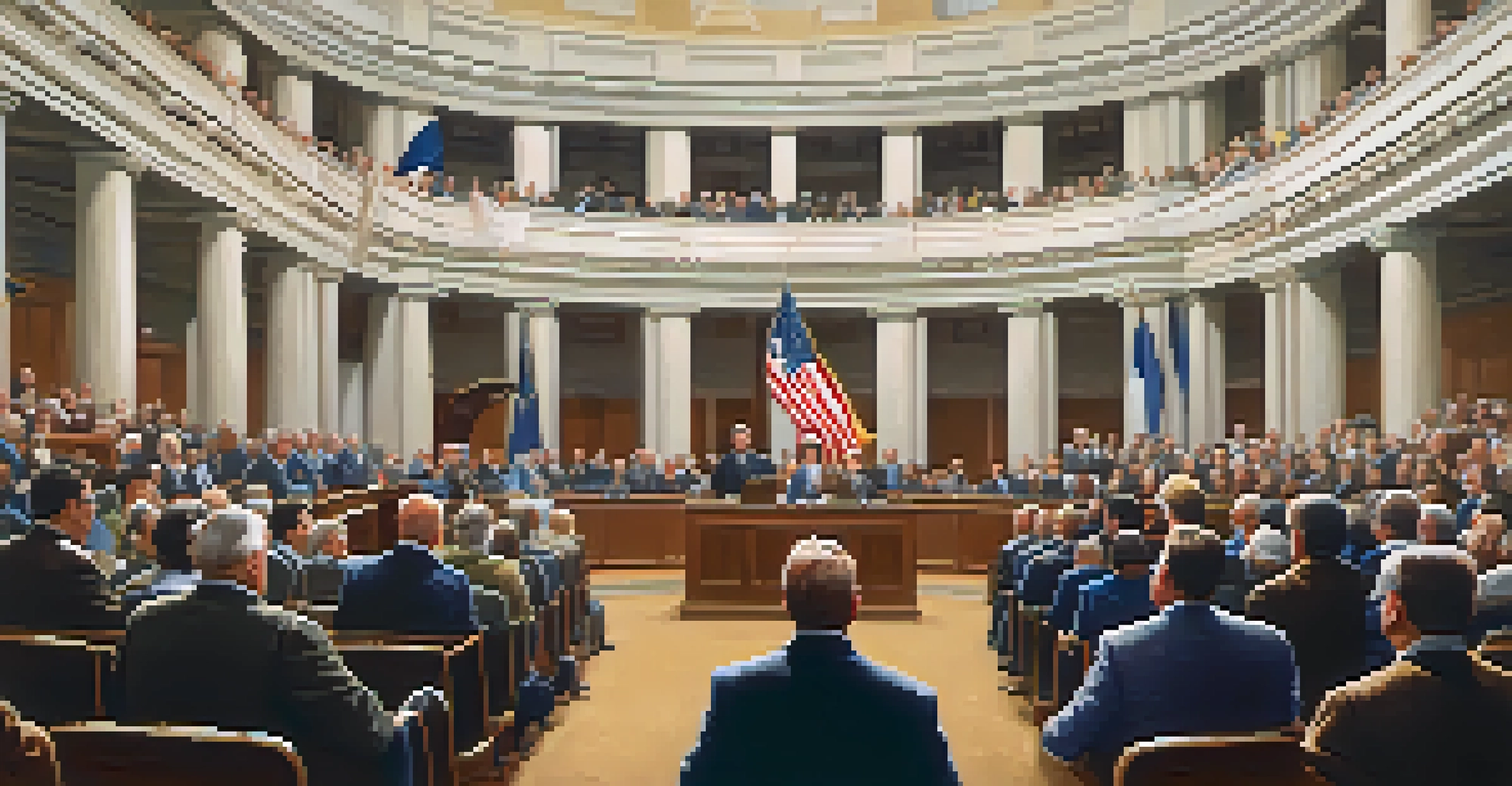Washington State Legislature: Structure and Legislative Process

Overview of Washington State Legislature's Structure
The Washington State Legislature is a bicameral body, meaning it has two chambers: the Senate and the House of Representatives. This structure allows for a system of checks and balances, ensuring that a variety of perspectives are considered in lawmaking. The Senate consists of 49 members, while the House has 98 representatives. Together, they work to create, amend, and pass legislation that affects the entire state.
The best way to predict the future is to create it.
Each chamber has its own leadership, including a Senate Majority Leader and a House Speaker, who guide the legislative process. The two chambers meet annually in Olympia, where they hold sessions to discuss various issues, propose bills, and debate legislation. This collaboration is crucial in addressing the diverse needs of Washington’s residents, from urban centers to rural communities.
Moreover, the legislative structure is designed to facilitate public participation. Citizens have the opportunity to engage with their elected representatives, attend committee hearings, and provide input on proposed legislation. This engagement fosters transparency and accountability in the legislative process.
Key Roles in the Washington State Legislature
Within the legislature, several key roles contribute to the effective functioning of government. Legislators, or state representatives and senators, are elected to represent their constituents' interests and are responsible for drafting and voting on bills. They often specialize in various policy areas, such as education, healthcare, or transportation, which helps them advocate effectively for their districts.

In addition to legislators, staff members play a vital role in supporting the legislative process. These individuals conduct research, prepare briefing materials, and assist in drafting legislation. Their expertise ensures that lawmakers have access to accurate information and analysis as they make decisions that impact the state.
Bicameral Structure of Legislature
Washington State's Legislature consists of two chambers, the Senate and the House of Representatives, which collaborate to create and pass laws.
Lastly, committees are essential components of the legislative process. Each chamber has various committees that focus on specific topics, allowing for more in-depth discussions and evaluations of proposed legislation. Committees streamline the legislative process by helping to identify key issues and develop recommendations before the full chamber votes.
The Legislative Session: What to Expect
The Washington State Legislature meets in regular sessions each year, typically starting in January. During these sessions, lawmakers work diligently to introduce and discuss bills, often focusing on the state budget, policy initiatives, and pressing issues. The session can last up to 105 days, with a biennial session occurring in odd-numbered years for the budget cycle.
Democracy is not a spectator sport.
As the session progresses, lawmakers hold public hearings where citizens can voice their opinions on proposed legislation. This open dialogue is crucial in shaping the final outcomes of bills, as it allows representatives to consider the views and concerns of their constituents. Community engagement is a vital part of the legislative process, ensuring that diverse voices are heard.
As the session nears its end, legislators must prioritize their agendas, deciding which bills to advance and which to set aside. This can lead to intense negotiations and collaboration as they work to reach compromises that benefit the state as a whole.
The Bill Proposal Process Explained
Proposing a bill in the Washington State Legislature is the first step in the legislative process. It typically begins when a legislator identifies a need or issue within their community and drafts a proposal. Each bill is assigned a unique number and title, which helps track its progress through the legislative system.
Once a bill is introduced, it is referred to a committee for review. The committee examines the bill in detail, often holding hearings to gather input from experts, stakeholders, and the public. This stage is crucial, as it determines whether the bill will move forward for further consideration or be set aside.
Public Engagement is Essential
Citizens are encouraged to participate in the legislative process through public hearings and communication with their representatives, fostering accountability.
If the committee approves the bill, it will then be scheduled for a vote in the chamber where it was introduced. A majority vote is required for the bill to advance to the other chamber, where the process is repeated. This thorough review ensures that legislation is well-considered before becoming law.
Understanding the Voting Process
Voting is a critical component of the legislative process, as it determines which bills become law. After extensive debate and discussion, legislators cast their votes on proposed legislation. In Washington State, voting can occur through voice votes, which are quick and informal, or roll-call votes, where each member's vote is recorded.
Majority approval is required for a bill to pass, but this can vary between chambers and specific types of legislation. For instance, certain bills may require a two-thirds majority, especially those impacting revenue or constitutional amendments. This requirement adds an additional layer of scrutiny and consideration.
If a bill passes both chambers, it is sent to the Governor for approval. The Governor can sign the bill into law, allow it to become law without a signature, or veto it. Understanding this voting process is essential, as it highlights how laws are created and the importance of each legislator's role in shaping state policy.
The Role of the Governor in Legislation
Once a bill has successfully passed through both the House and Senate, it lands on the Governor's desk. The Governor plays a pivotal role in the legislative process, as they have the power to approve or veto legislation. This authority allows the Governor to influence the direction of state policy significantly.
If the Governor approves the bill, it becomes law and is enforced throughout the state. However, if the Governor chooses to veto it, the legislature can still override this decision with a two-thirds majority vote in both chambers. This dynamic ensures that the legislative and executive branches maintain a balance of power.
Governor's Role in Legislation
The Governor has the authority to approve or veto bills, significantly influencing state policy and legislative priorities.
Additionally, the Governor often proposes legislation and influences the legislative agenda through their budget proposals and policy initiatives. This collaboration between the Governor and the legislature is vital in addressing the state's pressing needs and priorities.
Public Engagement and Advocacy in the Legislature
Public engagement is a cornerstone of the legislative process in Washington State. Citizens are encouraged to participate in a variety of ways, from attending public hearings to contacting their representatives with concerns or suggestions. This involvement fosters a sense of ownership and accountability in the democratic process.
Advocacy groups, both grassroots and established organizations, play a significant role in shaping public policy. These groups often mobilize constituents to support or oppose legislation, amplifying voices that may otherwise go unheard. Their efforts can significantly influence the outcome of bills by rallying public opinion and creating a sense of urgency.

Moreover, transparency in the legislative process is essential for building trust with the public. Legislators often provide updates on their work through social media and community forums, ensuring that constituents are informed about ongoing issues and decisions. This open communication enhances the relationship between lawmakers and the communities they serve.